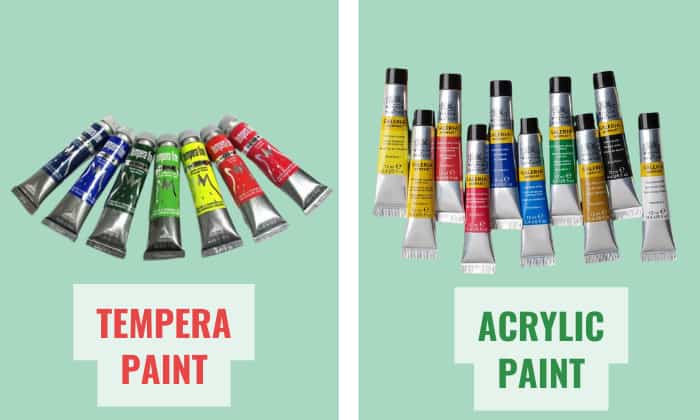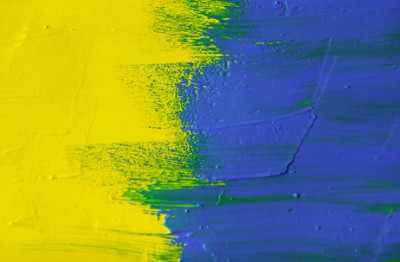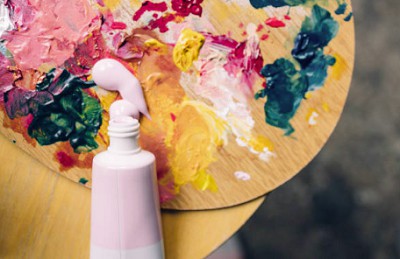When we talk about art, painting is one of the first things that comes to mind. There are different types of paints that you can explore.
In this article, we will talk about two of the most commonly used mediums for painting, tempera and acrylic paints. How are they similar or different from each other?
To start with, here’s a brief summary comparing the characteristics of tempera vs acrylic paint. This will give you some points to help you decide which one is better for you.
| Characteristics | Tempera Paint | Acrylic Paint |
| Ingredients | Pigment, Calcium Carbonate, starch, cellulose, and water | Pigment, polymer, and water |
| Lasting | Non-permanent, could be washable | Permanent after drying |
| Finish | Matte | Semi-glossy to glossy |
| Lightfastness | Has a tendency to fade | Lightfast |
| Viscosity | Creamy | Thick |
| Mixability | Highly mixable | Highly mixable |
| Drying Time | 10 to 15 mins | 20 to 30 mins |
Table of Contents
Tempera Paint
This type of paint is often mistaken as egg tempera, an ancient medium of painting which uses egg yolks mixed with pigment and water.
The use of egg tempera dates back to the 1st century, when there were still few mediums for painting. It was popularly used to draw famous personalities during that era.
On the other hand, modern tempera paints do not contain egg and utilizes starches and cellulose to bind with pigments, Calcium Carbonate, and water.
Tempera paints are also known as poster paint and are typically used for school projects and fun art activities.
They are available in powder form and in ready-to-use squeeze bottles by gallons. Some brands like Crayola and Prang offer their tempera paints in color sets.
Acrylic Paint
This paint is available in two varieties:
- Artist-grade acrylic paint
- Student-grade acrylic Paint
Acrylic paint is made with pigments, polymer that serves as the binder, and water. However, an artist’s grade formulation is, of course, more pricey than the student-grade acrylic paint.
But with artist-grade acrylic paint, you can get a more saturated pigment, and the range of colors are more extensive.
Students’ grade acrylic paint may have less coverage and fewer color options but could be the best option for newbies and artists on a low budget.
You can buy acrylic paint in a handy tube or in jars. If you are working on a large project, it is more practical to buy it in jars, but if you are still trying the paints out, a 2 oz. tube would be a good start.
What Makes Them Similar?
Tempera paint and acrylic paint are somewhat similar, since they are both water-based. This quality gives both paints the capability to be watered down or diluted with water.
Both types dry fast and have excellent mixability. These paints are good for beginners who are still finding their way to painting or for any type of school art projects.
What Are the Differences?
The tempera paint vs acrylic paint comparison chart shows that these options are different in many ways, starting from their ingredients, to longevity, finish, lightfastness, viscosity, and drying time.
1. Ingredients
The tempera paint definition emphasizes that it uses starch and cellulose as binders while acrylic paint, on the other hand, uses polymer. That alone makes both formulations different.
The difference in the formulas also says a lot about the actual usage, appearance, quality of the output, and more.
Tempera paint in modern times is mostly used for kids because its formulation is safe and non toxic. Acrylic paints with complex colors may be made with hazardous pigments, though acrylics in basic colors are usually non toxic.
2. Longevity, Lightfastness, and Mixability
The first two characteristics to consider are durability and longevity after application. Longevity refers to how the paint itself stays on the surface, and lightfastness refers to how the color resists fading when exposed to various sources of light.
Lightfastness classification is usually declared on the label. Paints with AA or ASTM I are rated as highly lightfast, while C or ASTM III is the poorest or an indication that the colors are highly fugitive.
Acrylic paints are highly mixable and soluble with water, but once dry, they become permanent or hard to remove. This type of paint is also known to retain its color for a longer period and is considered lightfast.
Tempera paints are absolutely mixable too but are less durable and less permanent. They can be scraped or washed after application. Tempera paint also tends to fade and lose its color intensity over time.
3. Finish and Consistency
Tempera paint produces an opaque matte finish that could be associated with the presence of Calcium Carbonate powder in its formulation. It also has a creamy and less viscous consistency.
Acrylic paint generally produces a semi-glossy to glossy finish, but in case you want your finish to be different, you can also use varnish to create your desired texture.
4. Drying Time
Both tempera and acrylic paint are known to dry quickly. However, tempera paint can dry a bit faster than acrylic. Tempera paint can dry within 10 to 15 minutes, while acrylic paint would take 20 minutes or longer.
How long does tempera paint take to dry in actual settings will also depend on the paint composition and brand. Some brands dry faster or longer than others regardless of the paint type.
Other factors like the surface of application, environmental condition, and how watery the paint is can also affect the drying time.
Pros and Cons
1. Tempera Paint
| PROS | CONS |
| Dries quickly | Too watery |
| Highly mixable | Less pigmented |
| Washable | Fewer color options |
| Affordable | Less permanent |
| Non toxic |
2. Acrylic Paint
| PROS | CONS |
| Dries quickly | Less time to work with since the paint sets in quick |
| Highly mixable | Color shifts to darker shades after drying |
| You can use water to clean-up brushes | Hard to clean once the paint is dried out |
| Can be used on a wide range of surfaces | Could be more expensive |
| Can use varnish and other mediums to achieve the desired finish | |
| Durable and lightfast | |
| Wide color options |
Cost
Tempera paint generally costs cheaper compared to acrylic paint. Check out the table below to see the actual prices according to different brands and sizes.
Tempera Paint
| Brand | Size | Price |
| Prang Ready-to-use assorted colors | 16 Oz, 12 bottles | $30.79 |
| Crayola Premier | 16 Oz. | $13.77 – $19.02 |
| Sargent Art Washable | 16 Oz. | $1.98 |
| Crayola Washable (Artista II) | 32 Oz. | $7.45 – $19.35 |
| Crayola Washable | 1 Gal. | $19.89 – $25.49 |
| Colorations Washable | 1 Gal. | $15.99 |
| Prang | 128 Oz | $15.89 – $30.57 |
| Sargent Art | 1 Gal. | $13.23 – 23.84 |
Note: Price may vary per color
Acrylic Paint
| Brand | Size | Price |
| Student Grade Acrylic Paint | ||
| Crayola | 2 fl Oz., 6 bottles. | $8.76 |
| Crayola Portfolio Series | 16 Oz. | $9.99 |
| Sargent Art | 16 fl Oz. | $3.88 |
| 64 Oz. (Half Gal.) | $22.11 | |
| Blickrylic | 16 Oz. | $6.97 |
| 32 Oz. | $11.24 | |
| 64 Oz. | $18.97 | |
| Artist Grade Acrylic Paint | ||
| Golden Heavy Body | 2 Oz., 6 tubes | $39.89 |
| 2 Oz. tube | $11.93 | |
| 16 Oz. jar | $56.75 | |
| Liquitex Prof Heavy Body | 2 Oz. tube | $6.95 |
| 16 Oz. jar | $28.07 | |
| 32 Oz. jar | $47.87 | |
| 2 Oz., 6 tubes | $47.87 | |
Note: Price may vary per color
Frequently Asked Questions or Helpful Tips
Is tempera paint the same as acrylic paint?
No, although they are water-based, tempera paint and acrylic paint are totally different.
As mentioned in the table above, they do differ in a lot of things. This is mainly because they are made of different ingredients and therefore behave and perform differently.
They also have different appearance after drying. Tempera paint dries into a matte finish while acrylic paint dries into a glossy or waxy finish.
Why do artists use tempera paint?
Tempera paint is affordable. Users can also mix and thicken it as they want, so it’s a great tool for budding artists.
In terms of composition, there are allergen-free tempera paints which suit people who are concerned about safety.
Can you paint acrylic over tempera?
Yes, but it is not generally advised. Again, these paints have different compositions that could affect compatibility.
However, if you must paint acrylic over tempera paint, apply the general rule, which is to make sure the first layer of paint is dry before applying any coloring.
Can you mix tempera and acrylic paint?
Yes, since both paints are water-based, it’s possible to mix them. But because their overall composition is still different, mixing tempera with acrylic might pose some issues. It is still better to use each paint separately.
Is tempera paint permanent? Is tempera paint washable?
Yes, it is washable and non-permanent. It is also simpler to wash off than acrylic paint that readily solidifies after drying.
However, regular tempera might still be a challenge to wash, especially on clothing and other porous surfaces.
Fortunately, you can always opt for washable versions, which are designed for kids and are readily available in the market.
Where can I use tempera paint?
Tempera paint can be used on different types of paper and cardboards. It is also suitable for poster making, paper mache, finger and sponge painting activities.
It can be used on plastic, but the surface has to be prepared first to ensure that the paint will stick on the surface. This includes sanding and adding a primer.
You may also use tempera paint on wood, on windows, and other surfaces, but it is limited to indoor set-up since it’s not waterproof.
Can you use tempera paint on canvas?
Yes. But using it on canvas is not common and may require additional technique or pre-treatment, such as adding talcum powder to it. Acrylic paints are far more suitable for canvas than tempera paint.
Can you make tempera paint into acrylic paint?
No. You can’t make tempera paint acrylic, but you can change the consistency of tempera to add texture or to make it buildable like acrylic. Some of the ways to do this is by adding starch or a bit of flour.
Conclusion
As both are excellent mediums for painting, when choosing between tempera vs acrylic paint, it is best to consider your purpose or the output that you want to achieve and the surface you want to work on.
For example, if you want to paint on canvas or want a more permanent result, then you’d better go with acrylic paint.
Meanwhile, if you are looking for a paint for school work and other children’s activities, tempera paint fits you best. It is cheap, safe, and washable.
Related: Steps to Use Acrylic Paint on Shrinky Dinks

Art has always been a part of my life; it influences my upbringing and later my career choice. For me, it is always a part of my parenting technique. So for whichever purpose that you come to art, you can start here with us.





